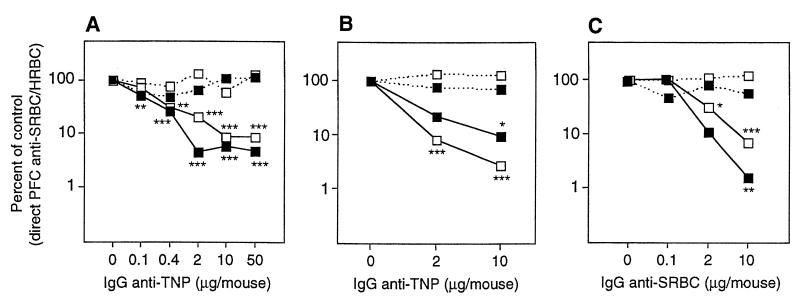Figure 2.
(A) Groups of four to five FcRγ−/− (lacking FcγRI + III) (open symbols) and C57BL/6 mice (solid symbols) were immunized with 4 × 106 SRBC-TNP and 8 × 105 HRBC preincubated with 0–50 μg of a mixture of equal amounts of monoclonal IgG1 (H5), IgG2a (7B4), and IgG2b (1B4) anti-TNP. Five days later the direct SRBC-specific (solid line) and HRBC-specific (broken line) PFC/spleen were assayed. The response is shown as the percentage of the response in control groups. PFC/spleen in the respective control groups (receiving antigen alone) were: FcRγ−/−, 178,969 SRBC, 16,133 HRBC; C57BL/6, 73,409 SRBC, 6,932 HRBC. This experiment was repeated twice using polyclonal IgG anti-SRBC without evidence of less efficient suppression in FcRγ−/− mice (not shown). (B) Groups of five β2m−/− (lacking FcRn) and C57BL/6 mice were immunized with 4 × 106 SRBC-TNP and 8 × 105 HRBC preincubated with 0, 2, and 10 μg of a mixture of equal amounts of monoclonal IgG1 (H5), IgG2a (7B4), and IgG2b (1B4) anti-TNP. Symbols and assay are as in A. PFC/spleen in the respective control groups (receiving antigen alone) were: β2m−/−, 77,854 SRBC, 49,238 HRBC; C57BL/6, 66,251 SRBC, 65,938 HRBC. This experiment was repeated once using 50 μg of polyclonal IgG anti-SRBC and SRBC, showing more than 99% suppression in both strains (not shown). (C) Groups of four (FcRγ−/− × FcγRIIB−/−) and C57BL/6 mice were immunized with 4 × 106 SRBC and 8 × 105 HRBC preincubated with 0–10 μg of polyclonal IgG anti-SRBC. Symbols and assay are as in A. PFC/spleen in the respective control groups (receiving antigen alone) were: (FcRγ−/− × FcγRIIB−/−), 54,055 SRBC, 104,172 HRBC; C57BL/6, 15,072 SRBC, 62,202 HRBC.

